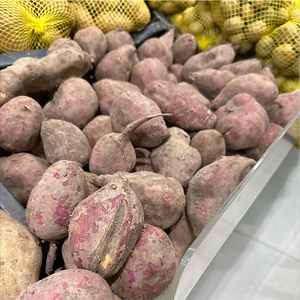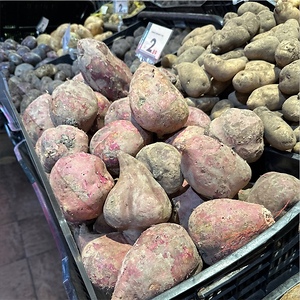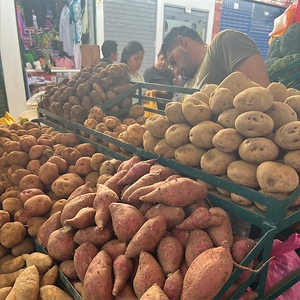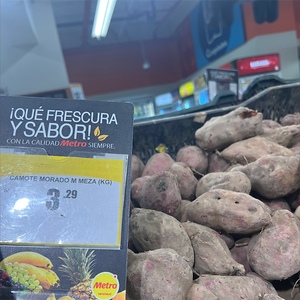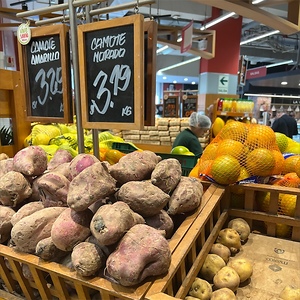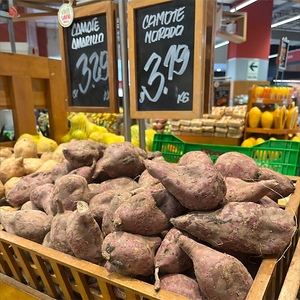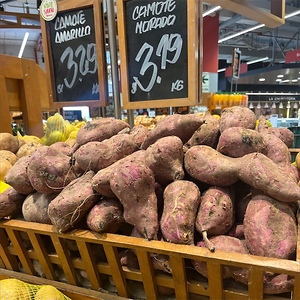

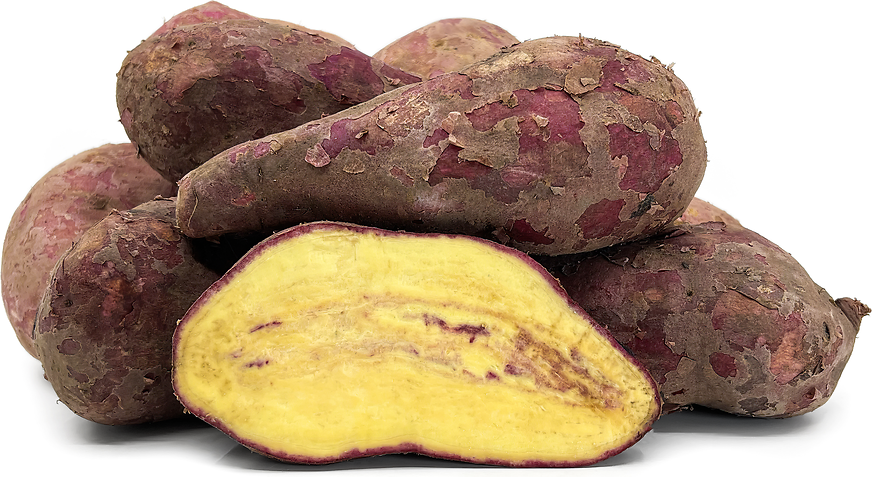
Purple Camotes
Estimated Inventory, lb : 0
Description/Taste
Purple Camotes vary in size from small the large, averaging 25-30 centimeters in length and are elongated to cylindrical in shape with tapered ends. The textured skin has a smooth, semi-rough consistency with a few shallow eyes and ranges in color from pink, red, purple, to light brown with a red undertone. Underneath the skin, the flesh is dense, dry, and cream-colored to light orange. When cooked, Purple Camotes develop a soft, starchy consistency and have a subtly sweet, nutty, and earthy flavor.
Seasons/Availability
Purple Camotes are available year-round.
Current Facts
Purple Camotes, botanically classified as Ipomoea batatas, are the edible, underground tubers that grow sprawling, leafy green vines above ground and are members of the Convolvulaceae family. In Spanish, camote means “sweet potato,” and there are hundreds of different verities of camotes throughout the world. Camotes are widespread in Central and South America for their sweet, creamy flesh and are often substitute for regular potatoes in culinary applications. Purple Camotes are also valued for their nutritional properties and filling nature.
Nutritional Value
Purple Camotes are an excellent source of potassium, vitamin C, and magnesium. They also contain calcium, fiber, and some antioxidants.
Applications
Purple Camotes are best suited for cooked applications such as baking, roasting, boiling, and steaming. The tubers can be boiled and mashed to create a sweet side dish, roasted and served with cooked meats, sliced and baked with cinnamon and honey, tossed into soups or stews, or baked into thin chips. Purple Camotes can also be used in sweet preparations such as ice creams and desserts. In Mexico, Purple Camotes are used on Dia De Los Muertos as an offering put on the altars for the souls of past family members. They are also sometimes used to make the sweet dessert known as camotes enmielados, which are sweet potatoes cooked in cinnamon syrup and are served during the Dia De Los Muertos celebration. Purple Camotes pair well with corn, carrots, garlic, cilantro, cinnamon, black beans, goat cheese, walnuts, limes, arugula, and meats such as poultry, ham, pork, and duck. The tubers will keep 1-2 weeks when stored in a cool, dry, and dark place.
Ethnic/Cultural Info
In Central America, camotes are a favorite snack item or a filling meal, and street vendors known as camoteros walk city streets with small carts to cook and sell fresh, hot tubers. Each cart typically contains a wood fire oven, and the camotero can choose to cook a variety of sweet potatoes or sell one specialty item like the Purple Camote. Camoteros also often cook plantains and coat them in lechera or sweetened condensed milk. A unique feature of the cart is the whistle on the end of the pipe where the steam is released from the oven. When the steam escapes, a whistle-like noise reverberates through the streets, similar to the sound of a train. This sound has become the camoteros signature noise, and though only a few vendors remain today, the steam whistle can still faintly be heard.
Geography/History
Purple Camotes are native to Central and South America and have been cultivated for thousands of years, appearing in ancient paintings, records, and engravings. Today Purple Camotes are found across the world under many different names and were spread via explorers and trade routes. The tubers are widely cultivated and can be found at fresh markets in South America, Central America, North America, Asia, Southeast Asia, and Australia.
Recipe Ideas
Recipes that include Purple Camotes. One
| Thyme & Love |
|
Mexican Candied Camotes |
| Rico Q |
|
Purple Camote Fries |
| Rico Q |
|
Peruvian Potato Mixed Grill |
| Pinch of Yum |
|
Camote Fritters |



